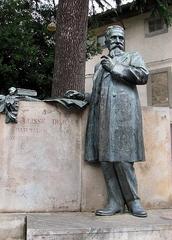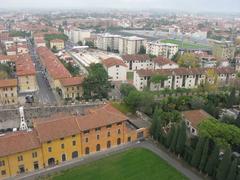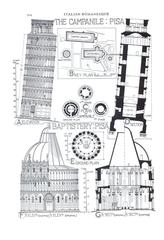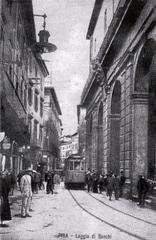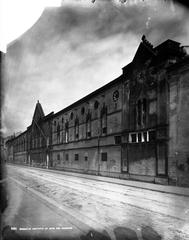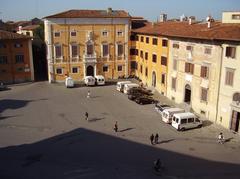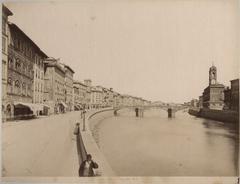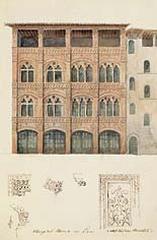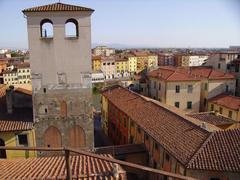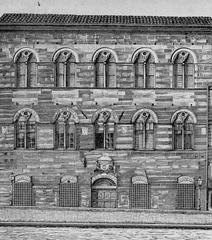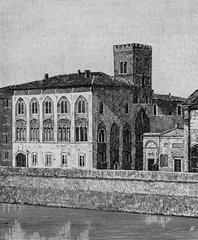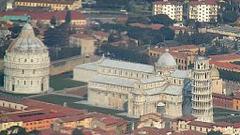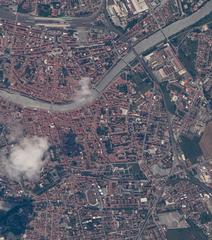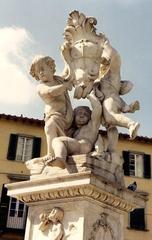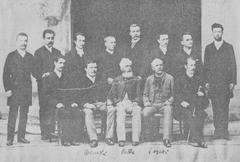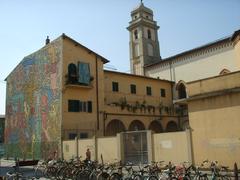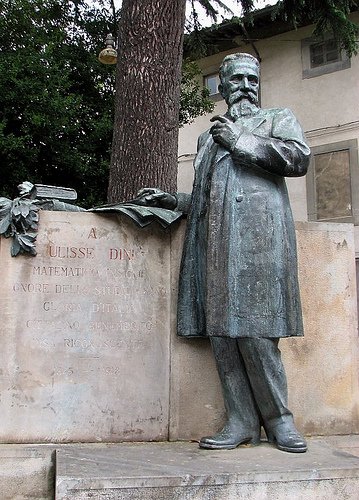
Monument to Ulisse Dini: Visiting Hours, Tickets, and Pisa Historical Sites Guide
Date: 14/06/2025
Introduction
The Monument to Ulisse Dini is a prominent cultural and historical landmark in Pisa, Italy, honoring one of the nation’s most distinguished mathematicians and civic leaders. Celebrating Dini’s profound contributions to mathematical analysis, differential geometry, and Pisa’s academic and civic identity, the monument invites visitors to explore not only the artistic achievements of its creators but also the vibrant scientific and intellectual heritage of Pisa.
Strategically set in the heart of the city—on Via Ulisse Dini, near Piazza dei Cavalieri, and close to the University of Pisa—the monument is surrounded by medieval architecture, lively student life, and some of Pisa’s most renowned attractions. Whether you are a scholar, history buff, or traveler, the Monument to Ulisse Dini offers a unique window into the city’s rich academic tradition and cultural landscape.
This guide provides comprehensive visitor information, including location details, visiting hours, accessibility, guided tours, historical background, artistic analysis, nearby attractions, and practical tips to enhance your visit.
For further details and up-to-date information, consult the official Pisa Tourism Board, the University of Pisa, and the Comune di Pisa.
Table of Contents
- Overview of the Monument to Ulisse Dini
- Location and How to Visit
- About Ulisse Dini: A Brief Biography
- Historical and Artistic Significance
- Nearby Attractions and Things to Do
- Visitor Experience and Practical Information
- Visuals and Media Resources
- Frequently Asked Questions (FAQ)
- Summary Table: Distances to Key Landmarks
- References and Further Resources
Overview of the Monument to Ulisse Dini
The Monument to Ulisse Dini stands as a distinguished tribute to a leading figure in Italian mathematics and public life. Dini’s pioneering work in analysis and geometry, as well as his service as rector of the University of Pisa and director of the Scuola Normale Superiore, are celebrated through this monument, which blends artistic realism with rich symbolism.
Located in Pisa’s academic center, the monument is an enduring symbol of the city’s commitment to knowledge, inquiry, and civic responsibility. Its public placement ensures free, year-round access for all visitors.
Location and How to Visit
Address and Accessibility
Primary Location:
Via Ulisse Dini, 56126 Pisa PI, Italy
(GPS: 43.7175° N, 10.3992° E)
The monument is just steps from Piazza dei Cavalieri, adjacent to the Scuola Normale Superiore, and within a short walk from the Leaning Tower of Pisa and Piazza dei Miracoli (Pisa Tourism). The area is pedestrian-friendly, with paved streets and nearby public transportation stops. Bicycles are also a popular way to reach the site.
Visiting Hours and Tickets
- Visiting Hours: Open 24 hours a day, seven days a week.
- Entrance Fee: Free; no ticket is required.
- Accessibility: The monument is at street level and wheelchair accessible, though some cobblestone areas may be uneven.
Guided Tours
- Guided walking tours focusing on Pisa’s scientific, academic, and artistic heritage frequently include the Monument to Ulisse Dini. These tours are available through local operators and the Pisa tourist office (Pisa Tourism).
- Academic institutions such as the University of Pisa also occasionally organize thematic tours and events.
About Ulisse Dini: A Brief Biography
Ulisse Dini (1845–1918) was a Pisa-born mathematician celebrated for his foundational work in real analysis and differential geometry. A graduate of the Scuola Normale Superiore di Pisa, Dini studied under Enrico Betti and continued his education in Paris. He later became a professor, rector, and director at Pisa’s leading universities, mentoring future luminaries like Luigi Bianchi.
Dini’s legacy includes the Dini criterion for Fourier series convergence and the implicit function theorem, pivotal in mathematical analysis (Kiddle). In addition to his scientific achievements, Dini was active in politics, serving as a city councilor, parliamentarian, and senator during a transformative period in Italian history (Italy On This Day).
Historical and Artistic Significance
Artistic Design and Materials
The monument was designed by the acclaimed sculptor Arturo Dazzi (1881–1966), known for his expressive realism (Treccani Enciclopedia). Erected in 1925, it features a life-sized seated statue of Dini in white Carrara marble, symbolizing intellectual purity and timeless achievement. The base is constructed from polished granite, with Dini’s name and dates elegantly inscribed.
Another version of the monument, a bronze statue by Leonardo Bistolfi, was installed in 1927 on Via Ulisse Dini, reinforcing the city’s recognition of Dini’s importance (Italy On This Day).
Sculptural Composition and Symbolism
Dazzi’s depiction shows Dini seated, holding an open book, representing his scholarly contributions. His posture and expression convey contemplation and the transmission of knowledge. The folds of his academic gown reinforce his status as a revered educator and rector.
The pedestal features a low-relief frieze with allegorical female figures personifying mathematical disciplines, such as geometry and astronomy, referencing classical Renaissance iconography (Museo della Grafica Pisa). A carved laurel wreath at the base symbolizes honor and achievement.
Artistic Influences and Context
The monument blends realism with symbolist elements, drawing inspiration from Renaissance masters and modernist trends. Its placement in a public square reflects the democratization of knowledge and the role of the university in civic life (Comune di Pisa).
Nearby Attractions and Things to Do
The Monument to Ulisse Dini is an excellent starting point for exploring Pisa’s historic and academic core:
- Piazza dei Cavalieri: Once the political center of Pisa, now home to the Scuola Normale Superiore (piazzadeicavalieri.sns.it).
- Palazzo della Carovana: Headquarters of the Knights of St. Stephen, adjacent to the monument.
- Church of Santo Stefano dei Cavalieri: Pisan Renaissance architecture, steps from the monument.
- Borgo Stretto: Medieval street with shops and cafes (Voyage Tips).
- Leaning Tower of Pisa (Piazza dei Miracoli): 800 meters away.
- Botanical Garden of Pisa: Historic university garden, 360 meters away.
- Royal Palace, Ponte di Mezzo, and several historic churches: All within a 500-meter radius.
Visitor Experience and Practical Information
Getting There and Accessibility
- By Foot: 10-minute walk from the Leaning Tower; 20 minutes from Pisa Centrale train station.
- By Public Transport: Multiple bus lines serve Piazza dei Cavalieri (Pisa Mobilità).
- By Bicycle: Pisa’s city center is bike-friendly with rental options.
The monument is accessible to visitors with disabilities, though some streets have cobblestones.
Best Times to Visit
- Daytime: Best for appreciating the monument and surroundings in natural light.
- Evening: The square is well-lit and less crowded, providing a peaceful atmosphere.
Safety, Amenities, and Photography
- The area is safe and frequented by students, locals, and tourists.
- Nearby cafes, shops, and public restrooms are available.
- Photographers will find excellent backdrops with historic facades and lively urban scenes.
Visuals and Media Resources
Visitors are encouraged to view high-quality images and virtual tours of the monument through the Pisa Tourism Board and the University of Pisa. Suggested alt text for images: “Monument to Ulisse Dini in Pisa near Piazza dei Cavalieri” and “Ulisse Dini statue with academic gown and book.”
Interactive maps and digital itineraries are also available on official tourism websites.
Frequently Asked Questions (FAQ)
Q: What are the monument’s visiting hours?
A: The Monument to Ulisse Dini is outdoors and accessible 24/7.
Q: Is there an entrance fee?
A: No, the monument is free to visit.
Q: Are guided tours available?
A: Yes. Many walking tours and academic itineraries include the monument. Check with local operators or the tourist office.
Q: Is the monument accessible for visitors with disabilities?
A: The area is generally accessible, though some cobblestone surfaces may be uneven.
Q: Can I take photographs?
A: Yes, photography is encouraged.
Summary Table: Distances from Monument to Key Landmarks
| Landmark | Distance (meters) |
|---|---|
| Piazza dei Cavalieri | 80 |
| Leaning Tower of Pisa | 800 |
| Borgo Stretto | 150 |
| Botanical Garden | 360 |
| Ponte di Mezzo (Arno River) | 350 |
| Royal Palace | 430 |
| Pisa Centrale Train Station | 1,500 |
For a detailed map, visit the official Pisa tourism website.
Conclusion
The Monument to Ulisse Dini is more than a commemorative statue—it’s a gateway to Pisa’s academic excellence, scientific tradition, and cultural vitality. Its central location, artistic merit, and educational significance make it a rewarding site for all visitors. Whether you’re exploring Pisa’s medieval squares, renowned universities, or famous landmarks like the Leaning Tower, be sure to include this monument in your itinerary.
For enhanced experiences, real-time updates, and personalized tour options, consider downloading the Audiala app and following local tourism resources. Pisa’s enduring spirit of inquiry and discovery awaits you at the Monument to Ulisse Dini.
References and Further Resources
- Official Pisa Tourism Board
- Monument to Ulisse Dini – Comune di Pisa
- Statue of Ulisse Dini – Pisa Tourism Board
- Ulisse Dini: Mathematician and Politician – Italy On This Day
- University of Pisa – History and Campus
- Museo della Grafica Pisa
- Arturo Dazzi – Treccani Enciclopedia
- Piazza dei Cavalieri Official Site
- Pisa Mobilità Public Transport
- Voyage Tips: Things to do in Pisa
- Kiddle: Ulisse Dini
